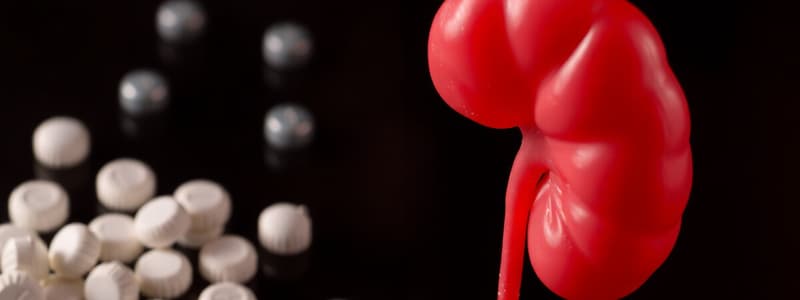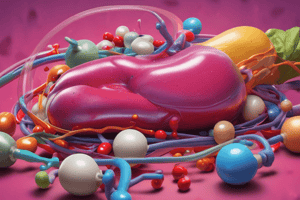Podcast
Questions and Answers
According to Hypertension Canada guidelines, which type of drug is recommended as a first-line treatment for hypertension?
According to Hypertension Canada guidelines, which type of drug is recommended as a first-line treatment for hypertension?
- Loop diuretics
- Potassium-sparing diuretics
- Thiazide diuretics (correct)
- Osmotic diuretics
What effect do diuretics have on extracellular fluid volume?
What effect do diuretics have on extracellular fluid volume?
- Increase extracellular fluid volume
- Cause unpredictable changes in extracellular fluid volume
- No change in extracellular fluid volume
- Decrease extracellular fluid volume (correct)
In the nephron, what substance primarily determines the movement of water?
In the nephron, what substance primarily determines the movement of water?
- Chloride
- Calcium
- Potassium
- Sodium (correct)
In which part of the nephron is the majority (60-70%) of sodium and water reabsorbed?
In which part of the nephron is the majority (60-70%) of sodium and water reabsorbed?
Which part of the nephron serves as the final common pathway for filtrate?
Which part of the nephron serves as the final common pathway for filtrate?
Which category of diuretics is typically considered the most potent?
Which category of diuretics is typically considered the most potent?
Acetazolamide (Acetazolam) belongs to which class of diuretic drugs?
Acetazolamide (Acetazolam) belongs to which class of diuretic drugs?
Carbonic anhydrase inhibitors primarily affect which area of the nephron?
Carbonic anhydrase inhibitors primarily affect which area of the nephron?
Which electrolyte is excreted in larger quantities due to the action of Carbonic Anhydrase Inhibitors?
Which electrolyte is excreted in larger quantities due to the action of Carbonic Anhydrase Inhibitors?
What condition, other than glaucoma, is a common indication for carbonic anhydrase inhibitors?
What condition, other than glaucoma, is a common indication for carbonic anhydrase inhibitors?
Which electrolyte imbalance is a contraindication for the use of carbonic anhydrase inhibitors?
Which electrolyte imbalance is a contraindication for the use of carbonic anhydrase inhibitors?
What is a common adverse effect associated with carbonic anhydrase inhibitors?
What is a common adverse effect associated with carbonic anhydrase inhibitors?
Furosemide (Lasix) belongs to which class of diuretics?
Furosemide (Lasix) belongs to which class of diuretics?
Where do loop diuretics primarily exert their effects in the nephron?
Where do loop diuretics primarily exert their effects in the nephron?
What is a common effect of loop diuretics on blood pressure?
What is a common effect of loop diuretics on blood pressure?
Which of the following is an indication for the use of loop diuretics?
Which of the following is an indication for the use of loop diuretics?
What is a common adverse effect associated with loop diuretics?
What is a common adverse effect associated with loop diuretics?
Mannitol (Osmitrol) is classified as what type of diuretic?
Mannitol (Osmitrol) is classified as what type of diuretic?
Where in the nephron does mannitol exert its primary effects?
Where in the nephron does mannitol exert its primary effects?
What is a common indication for using osmotic diuretics like Mannitol?
What is a common indication for using osmotic diuretics like Mannitol?
Spironolactone (Aldactone) is classified as what type of diuretic?
Spironolactone (Aldactone) is classified as what type of diuretic?
Potassium-sparing diuretics work primarily in which part of the nephron?
Potassium-sparing diuretics work primarily in which part of the nephron?
What is a common adverse effect associated with spironolactone (Aldactone)?
What is a common adverse effect associated with spironolactone (Aldactone)?
Hydrochlorothiazide (Urozide) is classified as what type of diuretic?
Hydrochlorothiazide (Urozide) is classified as what type of diuretic?
Where do thiazide diuretics primarily act in the nephron?
Where do thiazide diuretics primarily act in the nephron?
Flashcards
Diuretics
Diuretics
First-line hypertension treatment option that promotes fluid excretion.
Nephron Sodium Reabsorption
Nephron Sodium Reabsorption
Where sodium goes, water flows.
Diuretic Drug Types
Diuretic Drug Types
Drugs classified by site of action, chemical structure and potency.
Carbonic Anhydrase Inhibitors
Carbonic Anhydrase Inhibitors
Signup and view all the flashcards
Carbonic Anhydrase Inhibitors: Indications
Carbonic Anhydrase Inhibitors: Indications
Signup and view all the flashcards
Carbonic Anhydrase Inhibitors: Contraindications
Carbonic Anhydrase Inhibitors: Contraindications
Signup and view all the flashcards
Loop Diuretics
Loop Diuretics
Signup and view all the flashcards
Loop Diuretics: Indications
Loop Diuretics: Indications
Signup and view all the flashcards
Furosemide (Lasix)
Furosemide (Lasix)
Signup and view all the flashcards
Osmotic Diuretics
Osmotic Diuretics
Signup and view all the flashcards
Osmotic Diuretics: Indications
Osmotic Diuretics: Indications
Signup and view all the flashcards
Mannitol (Osmitrol)
Mannitol (Osmitrol)
Signup and view all the flashcards
Potassium-Sparing Diuretics
Potassium-Sparing Diuretics
Signup and view all the flashcards
Potassium-Sparing Diuretics: Indications
Potassium-Sparing Diuretics: Indications
Signup and view all the flashcards
Spironolactone (Aldactone)
Spironolactone (Aldactone)
Signup and view all the flashcards
Thiazide and Thiazide-Like Diuretics
Thiazide and Thiazide-Like Diuretics
Signup and view all the flashcards
Thiazide and Thiazide-Like Diuretics: Indications
Thiazide and Thiazide-Like Diuretics: Indications
Signup and view all the flashcards
Thiazide Diuretics: Adverse Effects
Thiazide Diuretics: Adverse Effects
Signup and view all the flashcards
Study Notes
- Diuretics are recommended as a first-line drug treatment option for hypertension.
- They cause direct arteriolar dilation, lead to a decrease in peripheral vascular resistance, and reduce extracellular fluid volume, plasma volume, and cardiac output which contributes to decreased blood pressure.
- In the nephron, water follows sodium. Water will not be absorbed and will be excreted as urine if sodium is not absorbed.
- Most potent to least potent diuretics: loop diuretics, mannitol (osmotic diuretic), metolazone (thiazide-like diuretic), thiazides, and potassium-sparing diuretics.
- Diuretics are classified according to their site of action, chemical structure, and potency.
Types of Diuretic Drugs
- Carbonic anhydrase inhibitors
- Loop diuretics
- Osmotic diuretics
- Potassium-sparing diuretics
- Thiazide and thiazide-like diuretics
Carbonic Anhydrase Inhibitors
- Acetazolamide (Acetazolam®) is the most commonly used carbonic anhydrase inhibitor. It is available in oral and parenteral forms.
- Benefits of use may outweigh potential fetal risks in pregnant women.
- Carbonic anhydrase inhibitors block carbonic anhydrase, preventing the exchange of H+ ions with sodium and water.
- Reduced H+ ion concentration in renal tubules, increases excretion of bicarbonate, sodium, water, and potassium; resorption of water is decreased, and urine volume is increased due to the inhibition of carbonic anhydrase.
- Used as adjunct drugs for long-term management of open-angle glaucoma and secondary glaucoma, edema secondary to heart failure, high-altitude sickness, and epilepsy.
- Contraindications: Known drug allergy, hyponatremia, hypokalemia, severe kidney or liver dysfunction, adrenal gland insufficiency, and cirrhosis.
- Adverse effects: Acidosis, hypokalemia, drowsiness, anorexia, paresthesias, hematuria, urticaria, photosensitivity, and melena.
- Interactions: Increased digoxin toxicity when combined with digoxin, hypokalemia with corticosteroids, and increased effects of amphetamines, carbamazepine, cyclosporine, phenytoin, and quinidine sulphate.
Loop Diuretics
- Examples: bumetanide, ethacrynic acid, and furosemide (Lasix®)
- Act on the ascending limb of the loop of Henle to block chloride and sodium resorption.
- Increase kidney prostaglandins, resulting in the dilation of blood vessels and reduced kidney, pulmonary, and systemic vascular resistance.
- Rapid onset and last at least 2 hours.
- Potent diuresis and subsequent loss of fluid which causes a reduction in blood pressure, pulmonary vascular resistance, systemic vascular resistance, central venous pressure, and left ventricular end-diastolic pressure.
- Can lead to potassium and sodium depletion and small calcium loss.
- Used for edema associated with heart failure and liver or kidney disease, hypertension control, increasing kidney excretion of calcium in patients with hypercalcemia and heart failure resulting from diastolic dysfunction.
- Adverse effects: dizziness, headache, tinnitus, blurred vision, nausea, vomiting, diarrhea, agranulocytosis, neutropenia, thrombocytopenia, hypokalemia, hyperglycemia, and hyperuricemia.
- Interactions: neurotoxic effects, nephrotoxic effects, increase serum levels of uric acid, glucose, alanine aminotransferase, and aspartate aminotransferase; thiazides (metolazone) cause sequential nephron blockade; NSAIDs may decrease the reduction of vascular resistance.
- Furosemide (Lasix): Most commonly used loop diuretic for pulmonary edema, edema associated with heart failure, liver disease, nephrotic syndrome, ascites, and hypertension.
Osmotic Diuretics
- Examples: mannitol (Osmitrol®), urea, organic acids, and glucose.
- Work along the entire nephron, mostly in the proximal tubule and descending loop of Henle.
- Nonabsorbable substances which produce an osmotic effect.
- Pull water into the renal tubules from the surrounding tissues.
- Inhibit tubular resorption of water and solutes, thus producing rapid diuresis.
- Increase glomerular filtration rate and renal plasma flow; help to prevent kidney damage during acute kidney injury, reduce intracranial pressure or cerebral edema associated with head trauma and excessive intraocular pressure.
- Used for treatment of patients in the early, oliguric phase of acute kidney injury, to promote excretion of toxic substances, to reduce intracranial pressure and cerebral edema and as a genitourinary irrigant in the preparation of patients for transurethral surgical procedures.
- Adverse effects: convulsions, thrombophlebitis, pulmonary congestion, headaches, chest pains, tachycardia, blurred vision, chills, and fever.
- Mannitol (Osmitrol): administered as intravenous (IV) infusion only. It may crystallize when exposed to low temperatures and requires the use of a filter.
Potassium-Sparing Diuretics
- Also known as aldosterone-inhibiting diuretics.
- Examples: amiloride (Midamor®), spironolactone (Aldactone®), and triamterene (often combined with hydrochlorothiazide).
- Work in the collecting ducts and distal convoluted tubules
- Interfere with sodium–potassium exchange and competitively bind to aldosterone receptors, block resorption of sodium and water usually induced by aldosterone secretion.
- Relatively weak compared with the thiazide and loop diuretics.
- Promote the excretion of sodium and water.
- Spironolactone and triamterene: Used for hyperaldosteronism, hypertension, reversing potassium loss caused by potassium-wasting diuretics, and certain cases of heart failure.
- Amiloride: Similar to spironolactone and triamterene but less effective in the long term.
- Adverse effects: dizziness, headache, cramps, nausea, vomiting, diarrhea, urinary frequency, weakness, and hyperkalemia.
- Spironolactone (Aldactone): Gynecomastia, amenorrhea, irregular menses, and postmenopausal bleeding.
- Interactions: Lithium, angiotensin-converting enzyme inhibitors, potassium supplements, and NSAIDs.
Thiazide and Thiazide-Like Diuretics
- Thiazide diuretics: hydrochlorothiazide (Urozide®)
- Thiazide-like diuretics: metolazone (Zaroxolyn®), chlorthalidone, and indapamide.
- Inhibit tubular resorption of sodium, chloride, and potassium ions in the distal convoluted tubule, resulting in osmotic water loss.
- Dilate the arterioles by direct relaxation.
- Decrease preload and afterload.
- Thiazides should not be used if creatinine clearance is less than 30 to 50 mL/min (normal is 125 mL/min), but metolazone remains effective to a creatinine clearance of 10 mL/min.
- Used for hypertension (most commonly prescribed), edematous states, idiopathic hypercalciuria, diabetes insipidus, and heart failure caused by diastolic dysfunction.
- Adverse effects: dizziness, headache, blurred vision, anorexia, nausea, vomiting, diarrhea, erectile dysfunction, jaundice, leukopenia, agranulocytosis, urticaria, photosensitivity, hypokalemia, glycosuria, hyperglycemia, hyperuricemia, and hypochloremic alkalosis.
Studying That Suits You
Use AI to generate personalized quizzes and flashcards to suit your learning preferences.




